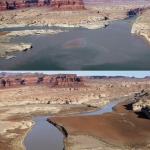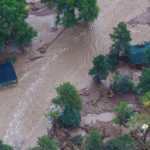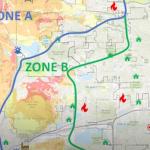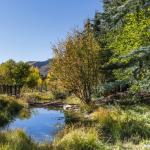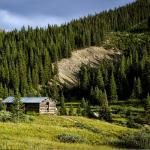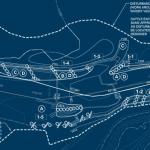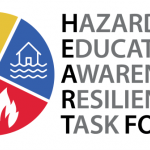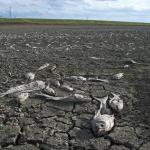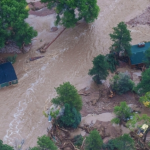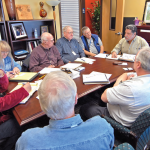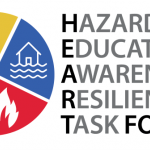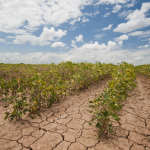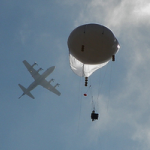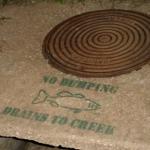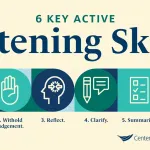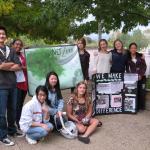Lesson Plans & Activities
Colorado Drought (Middle School)
This lesson is best taught at the beginning of a HEART Force unit, but it can also act as a stand-alone lesson to introduce students to drought in Colorado.
Students build an understanding of drought in Colorado using multiple data sources in a jigsaw activity.Lesson
Colorado-Based
Middle School

HEART Force Flood Response Game
This lesson is best used after the Colorado Flood lessons in the HEART Force curricular unit, for students to apply their learning and respond to a hypothetical flood in their own community.
This interactive game has students work in three “zone response teams” to solve community challenges that arise during the course of an extreme flooding event by using available individual and community resources.Game
Colorado-Based
Middle School
High School

The Vocabulary of Hazards
We suggest teaching this lesson to introduce the unit as it will benefit students in their understanding of natural hazards throughout the entire HEART Force Unit.
This lesson uses a matching game to build students' understanding and familiarity with different terms used in the world of resiliency planning.
Lesson
Colorado-Based
Middle School
High School

Envisioning a Resilient Future
We suggest teaching this lesson to introduce the HEART Force Unit.
In this lesson, students create a vision for the future of their community and identify what resources are most important to them as a starting point for resilience planning.
Lesson
Colorado-Based
Middle School
High School

Colorado Flood (Middle School)
This lesson is best taught at the beginning of a HEART Force unit, but it can also act as a stand-alone lesson to introduce students to floods in Colorado.
Students build an understanding of flooding in Colorado using multiple data sources in a jigsaw format.Lesson
Colorado-Based
Middle School

Colorado Wildfire (Middle School)
This lesson is best used as part of the HEART Force curricular unit, but it can also act as a stand-alone lesson to introduce students to wildfire in Colorado.
Students build an understanding of wildfire in Colorado using multiple data sources in a jigsaw format.Lesson
Colorado-Based
Middle School

HEART Force Wildfire Response Game
This lesson is best used after the wildfire hazard lesson in the HEART Force curricular unit, for students to apply their learning and respond to a hypothetical wildfire in their own community.
In this interactive game, students work in three “zone response teams” to solve community challenges that arise during the course of a wildfire event by using available individual and community resources.Game
Colorado-Based
Middle School
High School

HEART Force Drought Game
This lesson is best used after the Colorado Drought lessons in the HEART Force curricular unit, for students to apply their learning and respond to a hypothetical drought in their own community.
In this interactive game, students work in three "resilience teams" to solve community challenges that arise during the course of an extreme drought event by using available individual and community resources.Game
Colorado-Based
Middle School
High School

Flood Resilience in Colorado StoryMap
This is a lesson that can be used to get ideas and prepare for the Community Resilience Expo.
Students interact with a flood StoryMap to explore the Colorado Resiliency Framework.Lesson
Colorado-Based
Middle School
High School

Wildfire Resilience in Colorado StoryMap
This is a lesson that can be used to get ideas and prepare for the Community Resilience Expo.
Students interact with a wildfire StoryMap to explore the Colorado Resiliency Framework.Lesson
Colorado-Based
Middle School
High School

Exploring Local Hazard Mitigation Plans
This lesson is part of the Community Resilience Expo, a culminating event for the HEART Force curriculum unit, where students will share what they’ve learned during the hazard lesson and the role-playing game.
In this lesson, students will explore their county Hazard Mitigation Plan to gain understanding about the hazard in their area (flooding, wildfire, or drought), including historic hazards, probability of future occurrences of the hazard, and vulnerability of the area to the hazard.Lesson
Colorado-Based
Middle School
High School

Design a Resilient Future
This is a lesson that can be used to get ideas and prepare for the Community Resilience Expo.
In this lesson, students will work in small groups to develop an idea to increase community resilience, utilizing Design Thinking.Design Challenge
Colorado-Based
Middle School
High School

Community Resilience Expo Overview
The Expo is best taught at the end of HEART Force unit, after students are familiar with the hazard.
The Community Resilience Expo is a culminating event for the HEART Force curriculum, where students will develop and present original ideas to increase resilience in their community.
Unit
Colorado-Based
Middle School
High School

What Makes Cities Hotter?
This is the second lesson in the Climate Resiliency Education Middle School Climate Unit.
In this lesson, students explore reasons why temperatures in particular Colorado cities are rising.Lesson
Colorado-Based
Middle School
Why Are Growing Cities Hotter?
This is the third lesson in the Climate Resiliency Education Middle School Climate Unit.
This lesson has students explore what land use changes are happening and how changes in surface color affects temperatures in cities.
Lesson
Middle School
Are Other Parts of the World Getting Hotter?
This is the fourth lesson in the Climate Resiliency Education Middle School Climate Unit.
In this lesson, students investigate whether other parts of the world are changing and getting hotter just like Colorado.
Lesson
Middle School
How Do Cars Impact CO2 in the Atmosphere?
This is the seventh lesson in the Climate Resiliency Education Middle School Climate Unit.
During this lesson, students explore how fossil fuel burning in cars contributes CO2 to the atmosphere.
Lesson
Middle School
What Impact do Increasing Greenhouse Gases Have?
This is the sixth and final lesson in the Climate Resiliency Education High School Climate Unit.
In this lesson, students utilize case studies to learn about the ways climate change is currently impacting people and other living things around the world.
Lesson
High School
How Can We Decrease Our Impact on the Earth’s Climate at our School?
This is the first lesson in the Climate Resiliency Education Design Challenge Unit which was designed to follow the middle or high school Climate Resiliency Education units.
In this design challenge lesson students explore the Denver Public School District’s solid waste plan and discuss how their school can save or decrease emissions by reducing solid waste at our school.
Design Challenge
Colorado-Based
Middle School
High School
How Does Our School Food System Create Greenhouse Gas Emissions?
This is the second lesson in the Climate Resiliency Education Design Challenge Unit which is meant to follow the middle or high school Climate Resiliency Education units.
In this design challenge lesson, students examine their school food system and develop an investigation about food waste in order to know what should change.
Design Challenge
Colorado-Based
Middle School
High School
How Can We Understand Waste and Emissions in Our School's Food System?
This is the third lesson in the Climate Resiliency Education Design Challenge Unit which is meant to follow the middle or high school Climate Resiliency Education units.
This lesson outlines for students how to design and carry out an investigation to audit their school’s food waste system.
Design Challenge
Middle School
High School
How Can We Reduce Emissions Associated with Food Waste in Our School?
This is the fourth lesson in the Climate Resiliency Education Design Challenge Unit which is meant to follow the middle or high school Climate Resiliency Education units.
In this activity students utilize the data that is collected and propose solutions to mitigate food waste in their school.
Design Challenge
Middle School
High School
How Can We Present Solutions for Food Waste and Emissions at School?
This is the fifth lesson in the Climate Resiliency Education Design Challenge Unit which is meant to follow the middle or high school Climate Resiliency Education units.
This lesson provides guidance for students to create and practice a presentation about their design challenge results that they developed in the previous lessons and how to present it to the school administration.
Design Challenge
Middle School
High School
Colorado Flood (High School)
This lesson is best taught at the beginning of a HEART Force unit, but it can also act as a stand-alone lesson to introduce students to floods in Colorado.
The way we choose to design our communities has impacted community risk and vulnerability to flooding; in this lesson, students will explore this concept by analyzing environmental data to classify patterns and practice communicating their findings.Lesson
Colorado-Based
High School

Colorado Wildfire (High School)
This lesson is best used as part of the HEART Force curricular unit, but it can also act as a stand-alone lesson to introduce students to wildfire in Colorado.
Students build an understanding of wildfire in Colorado using multiple data sources in a jigsaw format.Lesson
Colorado-Based
High School

Wildfire Virtual Expo
This lesson provides a virtual alternative to the HEART Force Expo curriculum.
This is a streamlined lesson for students to prepare for a Community Resilience Expo, focusing on wildfire.
Design Challenge
Colorado-Based
Middle School
High School

Flood Virtual Expo
This lesson provides a virtual alternative to the HEART Force Expo curriculum.
This is a streamlined lesson for students to prepare for a Community Resilience Expo, focusing on flood.
Design Challenge
Colorado-Based
Middle School
High School

Drought Virtual Expo
This lesson provides a virtual alternative to the HEART Force Expo curriculum.
This is a streamlined lesson for students to prepare for a Community Resilience Expo, focusing on drought.Design Challenge
Colorado-Based
Middle School
High School

Communicate Existing Plans
This is a guide that can be used for a pathway for the Community Resilience Expo.
In this sub-unit, students will learn more about their community’s resilience plans, choose a specific topic to focus on, and develop a product to communicate the plan to their peers and/or their community.Lesson
Colorado-Based
Middle School
High School

HEART Force Curriculum Overview
This unit consists of several lessons and can take anywhere from 1 to 6 weeks to teach, depending on which lesson teacher choose to incorporate.
The HEART Force curriculum builds understanding of wildfire, flood, or drought in the context of place-based community resilience.
Unit
Colorado-Based
Middle School
High School

Colorado Drought (High School)
This lesson is best taught at the beginning of a HEART Force unit, but it can also act as a stand-alone lesson to introduce students to drought in Colorado.
Humans have been affected by severe drought throughout history; in this lesson students explore this concept by analyzing environmental data to classify patterns and practice communicating their findings.Lesson
Colorado-Based
High School

Arctic Feedbacks: Not All Warming Is Equal
This storyline unit consists of 10 lessons, each tied to NGSS Earth's systems standards
In this MS/HS unit, students engage with 360° virtual reality tours, authentic Arctic datasets, and app-based labs to construct models and explanations for the unit driving question, "Why might the Arctic be warming twice as fast as the rest of the world?"Unit
Polar Science
Middle School
High School
DISCOVER-AQ Curriculum Overview
The four DISCOVER-AQ modules can be completed independently, sequentially, or extended into a larger unit of study.
The DISCOVER-AQ curriculum integrates real-word research with real-life learning to answer the question: What are the causes and effects of air quality issues and how do they affect human health and the environment?
Unit
Middle School

Air Quality: More than Meets the Eye
The four DISCOVER-AQ modules can be completed independently, sequentially, or extended into a larger unit of study.
In this module, students engage in a visual demonstration on the causes & effects of air pollutants on air quality and kinesthetic activities on particulate matter & visibility.
Lesson
Middle School

Oh No, O3zone: “Good Up High, Bad Nearby!”
The four DISCOVER-AQ modules can be completed independently, sequentially, or extended into a larger unit of study.
This module teaches students about ozone’s role in the atmosphere and explores authentic data to compare and contrast conditions that affect ground-level ozone values.
Lesson
Middle School

Sherlock NOx: The Mystery of Unnatural Pollution in Natural Places
The four DISCOVER-AQ modules can be completed independently, sequentially, or extended into a larger unit of study.
Students take virtual field trips to explore air quality research sites and investigate the causes, effects, and solutions to nitrogen deposition in Rocky Mountain National Park during this module.
Lesson
Middle School

Carbon Gases CSI: Mobile Lab, Methane & More
The four DISCOVER-AQ modules can be completed independently, sequentially, or extended into a larger unit of study.
During this module, students take a virtual mobile lab drive with scientists to investigate and learn about atmospheric carbon gases, their sources, and impacts on air quality.
Lesson
Middle School

Waste, Water, and Wastewater
Project EXTREMES lessons were written to be stand alone lessons but can be incorporated into a larger unit.
In this lesson, students will apply what they know about how to separate a mixture by designing a wastewater treatment facility that effectively removes contaminants.
Lesson
Middle School

Active Listening Skills
This activity is one of seven activities in the Climate Mental Health Support Activities.
In this lesson, students will identify emotions they experience as they learn about the impacts of climate change. In pairs, students will practice active listening skills as one student describes their emotions to the partner who applies active listening skills. They then flip roles and the other student describes their emotions while the partner listens.Lesson
Middle School
High School
University/College

Facilitating Discussions and Creating Solidarity
This activity is one of seven activities in the Climate Mental Health Support Activities.
Talking about emotions related to climate change can help youth to process emotions, move on, and develop trust and connection with others through shared solidarity. In this lesson, students will discuss their thoughts and feelings about climate change with others. Consider teaching the Emotions Wheel and Active Listening activities before this in order to help students develop language and discussion skills.Lesson
Middle School
High School
University/College

